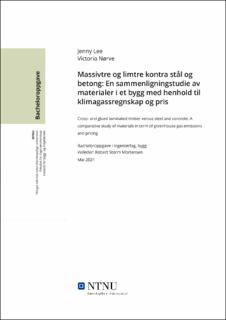| dc.contributor.advisor | Mortensen, Robert Storm | |
| dc.contributor.author | Lee, Jenny | |
| dc.contributor.author | Nørve, Victoria | |
| dc.date.accessioned | 2021-09-20T16:32:57Z | |
| dc.date.available | 2021-09-20T16:32:57Z | |
| dc.date.issued | 2021 | |
| dc.identifier | no.ntnu:inspera:81154281:81155170 | |
| dc.identifier.uri | https://hdl.handle.net/11250/2779547 | |
| dc.description.abstract | Klimaendringer på grunn av global oppvarming medfører alvorlige konsekvenser for hele verden. For å unngå å oppnå en temperøkning på 2 grader er det behov for raske reduksjoner i klimagassutslippene. Bygg- og anleggsbransjen står for omtrent 15,3 prosent av det norske klimagassutslippet.
Livssyklusanalyse (LCA) er et verktøy for å vurdere miljøpåvirkningen av et produkt eller et bygg gjennom hele livsløpet. Livsløpet starter ved uttak av råvarene helt til produktet ender som avfall eller gjenvinnes, dette kalles også fra «vugge til grav». Livsløpsanalysen gir informasjon om hvor mye utslipp de forskjellige delene gir og hvor i livsløpet det oppstår.
Det er gjort et klimagassregnskap for Vikhammer barnehage med hovedbæresystem i limtre og massivtre samt to omprosjekterte alternativer med hovedbæresystem i stål og betong. Alternativ 2 bygger på alternativ 1, men betongen har en strengere lavkarbonklasse. Mengdene til mengdeberegningene er hentet fra to IFC filer: RIB og ARK samt diverse rapporter fra prosjektet. Det er brukt LCA programmet One Click for klimagassberegningene. EPDene (Environmental Product Declaration) til materialene er hentet direkte fra programmets bibliotek. Fasene som er undersøkt i klimagassberegningene er produktfasene (A1-A3) og utskiftningsfasen (B4). Biogent karbonlagring fra trematerialene og karbonatisering av betong er ikke inkludert i klimagassberegningene.
Klimagassregnskapene viser tydelig hvilke materialvalg som fører til de største utslippene og gjør det lettere å se hvor stor effekt endringene har. Beregningene viser at begge omprosjekteringene gir et betydelig høyere klimagassutslipp enn referansebygget. Hvis biogent karbonlagring fra trematerialene er inkludert vil referansebygget få et negativt klimagassutslipp ved de utvalgte fasene. Det er spesielt innen fasene A1-A3 forskjellen mellom scenarioene er store. Det er likevel et tiltak som kan overføres fra alternativ 2 til referansebygget og vil føre til en betydelig reduksjon i klimagassutslipp. Ved å bruke betong med strengere lavkarbonklasse er det store utslipp som kan spares innenfor bygningsdelen grunn og fundamenter.
Konstadsberegningene viser at de omprosjekterte alternativene har lavere materialkostnader sammenlignet med referansebygget. Det er alternativ 1 som har lavest materialkostnader etterfulgt av alternativ 2. Det er relativt små summer som skiller de omprosjekterte alternativene fra hverandre.
Rapporten konkluderer med at selv om omprosjektert alternativ 1 har lavest materialkostnader vurderes det at økningen av klimagassutslipp ved omprosjekteringen er såpass stor at det er
urealistisk å bytte hovedbæresystemet uten å optimalisere bygget først. Til tross for at referansebygget har lavest utslipp av de tre scenarioene er det likevel muligheter for å redusere klimagassutslippet ved å velge betong med strengere lavkarbonklasse. | |
| dc.description.abstract | Climate change due to global warming has serious consequences for the whole world. To avoid reaching a temperature increase of 2 degrees, there is a need for rapid reductions in greenhouse gas emissions. The construction industry accounts for approximately 15,3 percent of the Norwegian greenhouse gas emissions.
Life cycle analysis (LCA) is a method for assessing the environmental impact of a product or a building throughout its life cycle. The life cycle starts with the extraction of the raw materials until the product ends up as waste or are recycled, this is also called «from cradle to grave ». The life cycle analysis provides information on how much greenhouse gas the different parts emits and where in the life cycle it occurs.
A greenhouse gas account has been prepared for Vikhammer kindergarten with a main support system in glue- and cross-laminated timber as well as two redesigned alternatives with a main support system consisting of steel and concrete. Alternative 2 builds on alternative 1, but the concrete has a stricter low-carbon class. The quantities for the quantity-calculations are taken from two IFC files: RIB and ARK as well as various reports from the project. The LCA program One Click has been used for the greenhouse gas calculations. The EPDs (Environmental Product Declaration) for the materials are downloaded directly from the program's library. The phases examined in the greenhouse gas calculations are the product phases (A1-A3) and replacement phase (B4). Biogenic carbon from the wood materials and carbonation of concrete are not included in the greenhouse gas calculations.
The greenhouse gas accounts show which material choices leads to the largest emissions and make it easier to see how big of an effect the change has. The calculations show that both redesigns provide significantly higher greenhouse gas emissions than the reference building. If biogenic carbon storage from the wood materials is included, the reference building will have negative greenhouse gas emission in the selected phases. It is especially within phases A1-A3 that the difference between the scenarios is significant. It is nevertheless something that can be transferred from alternative 2 to the reference building that will lead to further reduction in greenhouse gas emissions. By using a stricter low-carbon class concrete, large emissions from the foundation can be reduced.
The cost-calculations show that the redesigned alternatives have lower material costs compared to the reference building. Alternative 1 shows lowest material costs, followed by alternative 2. There are relatively small amounts that separate the redesigned alternatives from each other.
The report concludes that even though redesigned alternative 1 has the lowest material costs, it is considered that the increase in greenhouse gas emissions from the redesign is so large that it is unrealistic to change the main support system without optimizing the building first. Even though the reference building has the lowest greenhouse gas emissions out of the three scenarios, there are still opportunities to reduce greenhouse gas emissions by choosing concrete with a stricter low-carbon class. | |
| dc.language | nob | |
| dc.publisher | NTNU | |
| dc.title | Massivtre og limtre kontra stål og betong: En sammenligningstudie av materialer i et bygg med henhold til klimagassregnskap og pris | |
| dc.type | Bachelor thesis | |
